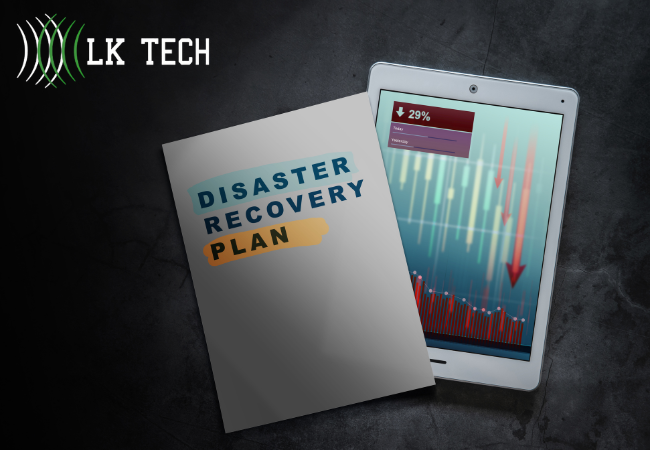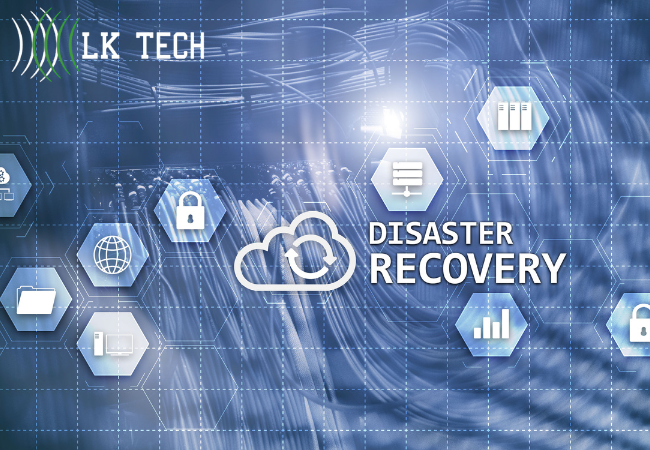In today's digital age, businesses heavily rely on their IT systems and data for smooth operations. However, the threat of natural disasters, cyberattacks, or hardware failures looms over these systems, highlighting the criticality of having a robust disaster recovery plan in place. This article will emphasize the importance of disaster recovery for businesses and provide an overview of available options.

Importance of Disaster Recovery for Businesses
Disaster recovery is the process of restoring technology infrastructure and data after an unexpected event. It plays a vital role in ensuring business continuity and minimizing downtime in the face of disruptions. Here are a few reasons why disaster recovery is crucial for businesses:
- Minimize Downtime: Downtime can have severe consequences for businesses, resulting in financial losses, customer dissatisfaction, and damage to reputation. Effective disaster recovery measures enable swift recovery, reducing the impact of downtime.
- Protect Data Assets: Data is a valuable asset for businesses, and its loss can be catastrophic. Disaster recovery ensures that critical data is backed up and can be restored in the event of a disaster, preventing data loss and potential legal and financial implications.
- Compliance and Regulations: Many industries have regulatory requirements for data protection and disaster recovery. By implementing a disaster recovery plan, businesses can meet these compliance standards and avoid penalties.
- Maintain Customer Trust: Customers rely on businesses to keep their data safe and maintain service availability. A solid disaster recovery plan demonstrates a commitment to data security and builds trust with customers.
Overview of Disaster Recovery Options
There are several disaster recovery options available to businesses, each with its own benefits and costs. Here's a brief overview of some common options:
| Disaster Recovery Option | Description |
| Cloud-Based Disaster Recovery | Leveraging cloud infrastructure for data backup and recovery. It offers scalability, cost-effectiveness, and remote accessibility. |
| Data Backup and Recovery Services | Outsourcing data backup and recovery to specialized service providers. It ensures off-site storage and expertise in data recovery. |
| Virtualization Solutions | Utilizing virtual machines and virtualization technology to replicate and recover critical systems. It provides flexibility and faster recovery times. |
Choosing the right disaster recovery option depends on various factors, including the business's budget, recovery time objectives (RTO), recovery point objectives (RPO), and the criticality of systems and data. For more information on assessing these factors, refer to our article on creating a disaster recovery plan.
Remember, disaster recovery is not a one-time effort but an ongoing process. Regular testing, monitoring, and updating of the disaster recovery plan are essential to ensure its effectiveness when needed. Additionally, businesses should allocate a budget for disaster recovery efforts, considering factors such as scalability, maintenance, and implementation costs.
Understanding the criticality of disaster recovery and exploring available options enables businesses to make informed decisions that protect their technology infrastructure and data, ensuring resilience against unforeseen events.

Least Expensive Options
When it comes to disaster recovery, businesses are often concerned about the cost implications. Fortunately, there are several cost-effective options available that can help businesses recover from disasters without breaking the bank. In this section, we will explore three of the least expensive disaster recovery options: cloud-based disaster recovery, data backup and recovery services, and virtualization solutions.
Cloud-Based Disaster Recovery
Cloud-based disaster recovery has gained significant popularity in recent years due to its cost-effectiveness and flexibility. With this option, businesses can leverage cloud infrastructure and services to replicate and store their critical data and systems off-site. In the event of a disaster, this data can be quickly restored to ensure business continuity.
One of the key advantages of cloud-based disaster recovery is the pay-as-you-go pricing model. Businesses only pay for the resources they use, eliminating the need for upfront investments in hardware and infrastructure. Additionally, cloud providers often offer scalable storage and computing capabilities, allowing businesses to adjust their disaster recovery resources based on their needs. This scalability provides cost savings by eliminating the need to over-provision resources.
To implement cloud-based disaster recovery, businesses should carefully assess their requirements and select a reputable cloud service provider. It's essential to consider factors such as data security, encryption, and compliance when choosing a provider. LK Tech prioritizes data security with robust encryption protocols and adherence to stringent compliance standards. Our cloud solutions are designed to mitigate risks associated with data breaches and ensure regulatory compliance, providing peace of mind to businesses across various sectors. By partnering with LK Tech, you can leverage our expertise to fortify your data protection measures and maintain operational continuity during disruptive events.
Data Backup and Recovery Services
Data backup and recovery services offer businesses a simple and cost-effective way to protect their critical data. These services involve regularly backing up data to an off-site location, which can be quickly restored in the event of data loss or system failure.
Outsourcing data backup and recovery to a service provider allows businesses to avoid substantial upfront investments in hardware and infrastructure. Instead, they can opt for a monthly or annual fee based on the volume of data backed up and the desired service level.
Data backup and recovery services often offer scalable solutions, allowing businesses to adjust their backup requirements as their data grows. This scalability ensures that businesses only pay for the storage and recovery services they need, reducing unnecessary costs.
Virtualization Solutions
Virtualization solutions provide businesses with a cost-effective way to recover their IT infrastructure in the event of a disaster. Virtualization involves creating virtual versions of physical servers, networks, and storage devices. These virtual environments can be quickly spun up in a disaster recovery scenario, minimizing downtime and ensuring business continuity.
One of the main advantages of virtualization solutions is their ability to consolidate multiple physical servers into a single virtual server, leading to cost savings on hardware and maintenance. Additionally, virtualized environments can be easily replicated and stored off-site, reducing the need for expensive secondary data centers.
To implement virtualization for disaster recovery, businesses should consider working with experienced IT professionals who can help design and manage the virtualized infrastructure. This ensures that the virtualized environment is properly configured and ready for use in the event of a disaster.
Exploring cost-effective disaster recovery options such as cloud-based solutions, data backup services, and virtualization can help businesses protect critical systems and data without incurring excessive costs. Assessing your business's specific needs and selecting the most suitable option based on budget and recovery objectives is crucial. Disaster recovery is a vital investment for ensuring business continuity and should be prioritized accordingly.
Factors Influencing Cost
Considering disaster recovery options for your business involves understanding factors that influence cost. Cost-effectiveness is crucial, but evaluating specific business needs is essential. Here are three factors impacting the cost of implementing a disaster recovery solution:
Scalability and Flexibility
Scalability and flexibility are important factors to consider when assessing the cost of a disaster recovery solution. As your business grows and evolves, your disaster recovery needs may change. A solution that offers scalability allows you to expand or contract your resources based on your current requirements. This scalability can help you optimize costs by ensuring that you only pay for the resources you need at any given time.
Flexibility is also crucial in accommodating different business requirements. A disaster recovery solution that offers flexibility allows you to choose the level of protection and recovery capabilities that align with your budget and priorities. By tailoring the solution to your specific needs, you can avoid unnecessary expenses and focus on the most critical aspects of your business.
Maintenance and Support Costs
Maintenance and support costs are an essential consideration when evaluating the overall cost of a disaster recovery solution. These costs include ongoing maintenance, updates, and technical support services. It's important to understand the level of support provided by the vendor or service provider and the associated costs.
Some disaster recovery solutions may require regular maintenance, software updates, or periodic testing to ensure optimal performance. These activities help to identify and address any vulnerabilities or gaps in the system. While maintenance and support costs are necessary for maintaining a reliable disaster recovery solution, it's important to consider these expenses when budgeting for your overall IT costs.
Implementation and Integration Expenses
The implementation and integration of a disaster recovery solution can also impact the cost. It's important to consider the expenses associated with setting up the solution, such as hardware, software, licenses, and any required infrastructure upgrades. Additionally, integration costs should be taken into account if the solution needs to be integrated with existing systems and processes.
The complexity of the implementation and integration process can vary depending on the solution chosen and the existing IT infrastructure of your business. It's essential to plan for these expenses and allocate resources accordingly to ensure a smooth and successful implementation.
Considering factors such as scalability, flexibility, maintenance and support costs, implementation, and integration expenses is crucial when selecting a disaster recovery option that aligns with your budget and business requirements. Careful evaluation of your needs, consultation with IT professionals, and consideration of the long-term benefits and cost savings of a robust disaster recovery solution are essential steps in ensuring business continuity and resilience.

Implementing a Cost-Effective Strategy
When it comes to disaster recovery, implementing a cost-effective strategy is crucial for businesses looking to protect their critical systems and data without breaking the bank. By focusing on key areas such as creating a disaster recovery plan, monitoring and testing procedures, and budgeting for disaster recovery efforts, businesses can ensure they are prepared for any potential disasters while keeping costs in check.
Creating a Disaster Recovery Plan
A well-designed disaster recovery plan is the foundation of a cost-effective strategy. It provides a roadmap for responding to and recovering from disruptions, ensuring that businesses can resume their operations as quickly as possible. When creating a disaster recovery plan, consider the following:
- Identify Critical Systems and Data: Determine which systems and data are essential for your business operations. This will help prioritize recovery efforts and allocate resources effectively.
- Define Recovery Time Objectives (RTO) and Recovery Point Objectives (RPO): RTO and RPO are key metrics that determine how quickly you need systems and data to be recovered. Establishing realistic RTO and RPO targets ensures that your disaster recovery plan aligns with your business requirements.
- Establish Recovery Procedures: Outline step-by-step procedures for recovering systems and data. This includes identifying backup locations, specifying recovery methods, and documenting necessary configurations. Regularly reviewing and updating these procedures is essential to ensure their effectiveness.
Monitoring and Testing Procedures
To ensure the effectiveness of your disaster recovery strategy, regular monitoring and testing procedures should be in place. This allows you to identify and address any potential issues before a disaster occurs. Consider the following:
- Continuous Monitoring: Implement monitoring tools and processes to keep a close eye on the health and availability of your systems. This enables proactive identification of potential vulnerabilities or failures, allowing for timely intervention.
- Regular Testing: Perform regular disaster recovery testing to validate the effectiveness of your plan. This includes simulating various disaster scenarios and evaluating the response and recovery processes. Regular testing helps identify any gaps or weaknesses in your strategy and allows for necessary adjustments to be made.
Budgeting for Disaster Recovery Efforts
Budgeting for disaster recovery efforts is an essential part of implementing a cost-effective strategy. Proper allocation of resources ensures that your business is prepared for potential disasters without unnecessary financial strain. Consider the following budgeting considerations:
- Evaluate Costs: Assess the costs associated with implementing and maintaining your disaster recovery plan, including hardware, software, and staff resources. Ensure that the allocated budget is sufficient to cover these expenses.
- Prioritize Investments: Identify the most critical systems and data that require immediate and robust protection. Allocate a larger portion of your budget towards securing and recovering these assets, while considering cost-effective options for less critical components.
- Consider Cloud-Based Solutions: Cloud-based disaster recovery solutions offer scalability and flexibility without the need for significant upfront investment. Explore the benefits and cost savings associated with cloud-based options, such as cloud-based disaster recovery.
Creating a robust disaster recovery plan, implementing thorough monitoring and testing procedures, and budgeting effectively are key steps in establishing a cost-effective disaster recovery strategy. This approach ensures that critical systems and data remain protected without incurring unnecessary expenses. It's important to recognize that disaster recovery is an ongoing process, requiring regular reviews and updates to adapt to evolving business needs and technological advancements. This proactive approach helps businesses maintain continuity and resilience in the face of potential disruptions.

Discover Cost-Effective Disaster Recovery Solutions with LK Tech!
Explore the best options for disaster recovery tailored to your business needs with LK Tech. As a trusted provider of IT services, including disaster recovery solutions, we specialize in minimizing costs while maximizing protection. Whether you're considering cloud-based solutions, data replication, or backup strategies, our expert team ensures solid recovery options.
Contact LK Tech today to discuss how we can safeguard your business continuity with our reliable disaster recovery services in Cincinnati.


